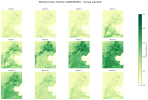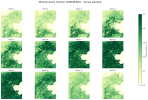I want to examine the impact of changes in vegetation cover on the study area, so I replaced the GREENFRAC parameter in geo_em_d03. I have confirmed that the replacement was successful and that there is a significant difference compared to the default values, as shown in the figure below.


After replacing the parameter, I re-ran metgrid, real, and wrf. However, the results from the two simulations are exactly the same (using T2 as an example). I would like to know how to ensure that the modified GREENFRAC actually takes effect. My namelist file is as follows.


After replacing the parameter, I re-ran metgrid, real, and wrf. However, the results from the two simulations are exactly the same (using T2 as an example). I would like to know how to ensure that the modified GREENFRAC actually takes effect. My namelist file is as follows.
